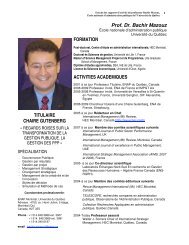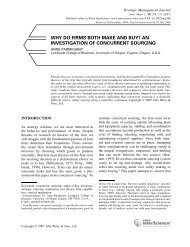Make or Buy Urban Public Transport Services: A Rational Choice?
Make or Buy Urban Public Transport Services: A Rational Choice?
Make or Buy Urban Public Transport Services: A Rational Choice?
You also want an ePaper? Increase the reach of your titles
YUMPU automatically turns print PDFs into web optimized ePapers that Google loves.
services in city i in 2006. The alternative modes of urban transp<strong>or</strong>t service provision<br />
are: in-house provision, outsourcing to a semi-public company and outsourcing to a<br />
private company. Consequently, the variable Organization i takes the value 1 if in<br />
2006 the local government provided the service in house; it takes the value 2 if in 2006<br />
the urban public transp<strong>or</strong>t service was provided by a semi-public company; at last, it<br />
takes the value 3 if in 2006 the provision of the service was outsourced to a private rm.<br />
To test whether our predictions are c<strong>or</strong>rob<strong>or</strong>ated in the French urban public transp<strong>or</strong>t<br />
sect<strong>or</strong>, we need to relate our predictions to the data. As our propositions stress the<br />
imp<strong>or</strong>tance of contracting diculties on the one hand and non monetary determinants<br />
on the other hand, we need to identify variables that impact on these aspects. The<br />
set of variables we introduce in the right-hand side are the following 6 .<br />
4.1 Economic determinants<br />
Complexity. Our rst set of variables accounts f<strong>or</strong> the complexity of the service<br />
perf<strong>or</strong>med by the operat<strong>or</strong>. These variables proxy not only f<strong>or</strong> the complexity of the<br />
service, but also f<strong>or</strong> the level of (human) specic investments needed to operate the<br />
service, a key variable from an incomplete contract perspective. Indeed, the m<strong>or</strong>e<br />
complex the denition of a service and the higher the level of human assets specicity<br />
required to deliver it, the m<strong>or</strong>e costly it is to write and administer a contract with an<br />
external provider, and consequently the lower the likelihood to outsource the provision<br />
of the service.<br />
Numerous the<strong>or</strong>etical and empirical studies have highlighted that urban public transit<br />
planning is a dicult task, requiring highly specic human skills 7 (see Guihaire and<br />
Hao (2008) f<strong>or</strong> a recent survey). M<strong>or</strong>e precisely, the diculty to design and operate<br />
an urban transit netw<strong>or</strong>k is shown to depend on the number of bus stops and on<br />
the population density, as these two dimensions strongly inuence frequency settings,<br />
timetable development but also buses and drivers scheduling. Consequently, our proxy<br />
f<strong>or</strong> the level of service complexity associated with a particular netw<strong>or</strong>k is the variable<br />
Complexity i , which c<strong>or</strong>responds to the ratio of the number of bus stops over the pop-<br />
6 As we aim at explaining <strong>or</strong>ganizational decisions that prevailed in 2006 but were sometimes taken<br />
several years bef<strong>or</strong>e, we chose to retain as a reference period f<strong>or</strong> the vect<strong>or</strong>s of explanat<strong>or</strong>y variables<br />
the year preceding the expiration of the contract f<strong>or</strong> those netw<strong>or</strong>ks operated by external contract<strong>or</strong>s<br />
(whether semi-public <strong>or</strong> private companies). As f<strong>or</strong> the publicly managed netw<strong>or</strong>ks, we took the last<br />
year at our disposal (2006) because we consider that this provision mode is challenged every year<br />
7 Results of a recent empirical study by Brown and Potoski (2005) supp<strong>or</strong>t this view. They asked<br />
a sample of public managers to rank 64 local services in the US along two contracting dimensions :<br />
asset specicity and ease of measurement. They found urban transp<strong>or</strong>t services to display high asset<br />
specicity and modest ease of measurement. In particular, they found that urban transit raises higher<br />
contracting diculties than solid waste collection and disposal. Also, their results indicate that water<br />
management (distribution and treatement) displays higher asset specicity but lower measurement<br />
diculties than urban public transp<strong>or</strong>t<br />
9





